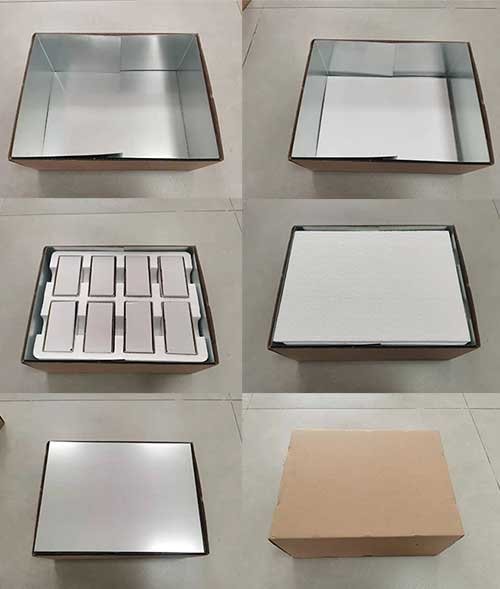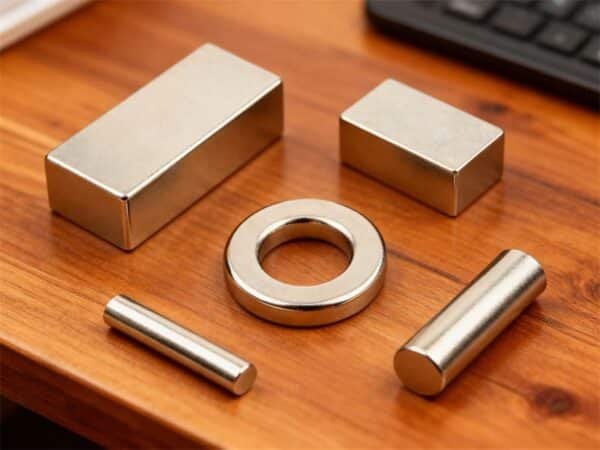Packing and Shipping magnets may seem simple, as you just place them in a box and ship them, right? I used to believe that, too, until I had a shipment detained at customs for weeks because I hadn’t properly boxed it.
The truth is that shipping magnets, particularly strong neodymium or industrial-grade magnets, is cumbersome because of their large shipping fields. Safely packing magnets isn’t as simple as it sounds; it often needs someone with expertise to handle it appropriately. We need to be cautious when handling magnets, and that’s generally due to their strong magnetic forces.
I’ve been in this industry for over a decade and have extensive experience. So today, we’ll discuss how to pack and ship magnets.
So, let’s start.

1. How to Pack Magnets in Shipping
The proper packing is the key factor while packing magnets for shipping. Well, let me tell you that the type and size of the magnet doesn’t matter. The thing mostly matters is to prevent the movement and contain magnetic field while transportation.
1.1 General Packing Rules
- i. First of all, and most importantly, it is essential to block or redirect the magnetic shield while packing magnets. For that, I use steel plates, magnetic shielding foil, or even tin boxes. Airport screening equipment could be affected by the nearby packages of the smallest neodymium magnets if proper shielding is not utilized.
- ii. If we secure the magnets well, it will prevent the shifting and colliding. So I pack them firmly with foam inserts and then in solid cardboard or bubble wrap, because movement could increase the risk of damage when magnets slam into each other.
- iii. Third step is really important to know the quality of packing, which I never skip. Field leakage testing is a mandatory step that should never be avoided. So I always use a magnetometer app or a compass for the package to check if the field extends beyond the box. And if the needle moves considerably, well, it is time to go back and improve the packing quality.
- iv. The last but not least step is to label the package to inform everyone who comes in contact with the package. So I label every package with the precautions, saying ‘Magnetized Material’ or ‘Caution: Magnets inside.’ It helps to improve the trust relationship with the service provider, plus helps with the safety of people around.
1.2 Small and Individual Magnets
- i. Well, small magnets are easy to ship, but of course, they demand precautionary measures at the same time. For proper care, I pack every magnet individually in solid foam or bubble wrap to reduce its magnetic effects.
- ii. If you want more protection, then a metal container would be the best choice for more protection. Most of the time, I wrap magnets into a tin container and then put it into a large box to avoid any impact or movement during travel.
1.3 Multiple Magnets
- i. If you are shipping multiple magnets together, they must be packed tactfully so that magnetic buildup can be handled carefully. So I have a trick for that: I always position magnets with alternating opposites against each other. This makes sure to minimize their combined field strength.
- ii. Spacers play a vital role in separating the magnets. So I place some non-magnetic material or thick foam among them to avoid attraction.
- iii. All this procedure makes the field leakage limited. Then I enfold them in some metal container, covering them with magnetic shielding panes before boxing.
1.4 Large and Strong Magnets
- i. Specialized packing by a professional person is required when you are packing some large and strong magnets, like neodymium or any other industrial magnet. Large magnets are dangerous and require special caution; otherwise, it could damage electronics, crush fingers, or pull nearby objects by its giant power.
- ii. I am aware of the power of a large and strong magnet, so I always separate them into parts and then insert 2 inches of dense foam or a wooden sheet between the magnets. This will minimize its field of attraction.
- iii. Large magnets demand a metal shield and a big warning, which I write on the parcel like ‘Strong Magnet—Handle with Care—Keep Away from Metal Electronics.’ This method also ensures the shipping standards and makes everyone aware of the risk.
2. How to Store Magnets
Before shipping the magnets, of course, storage is a necessity. Here I am sharing all the tips I keep in mind while storing the magnets.
- · Cool and dry environment: Always keep your magnet in a cool and dry place, because humidity can cause rust, especially in neodymium magnets.
- · Always use spacers: Always insert wooden blocks or foam among arranged magnets.
- · Keep them away from electronics: Keep them away from the sensitive equipment and metal electronics.
- · Label Storage Boxes: Anyone who goes near the boxes should be aware of what it has inside, so always label them properly.
3. How to Shipping Magnets
Actually, the method of shipping magnets depends on the destination and the strength we are delivering. All the shipping companies have their own methods and means for transportation, and it totally depends on the weight and capacity of the magnet you are transporting.
🚛 3.1. Road Transport (Truck / Ground)
- Features: Few restrictions, most logistics companies can handle it.
- No strict magnetic field testing required (unlike air).
- Lower cost, suitable for domestic or short-distance transport.
- Packaging must be strong enough to withstand vibration during long trips.
Notes:
- Still need padding/foam to prevent magnets from sticking to the truck’s metal walls.
- Prevent magnets from colliding with each other.
🚂 3.2. Rail Transport
- Features: Similar to road, relatively loose regulations.
- Large capacity, good for bulk and long-distance shipments.
- Packaging must be strong enough to withstand vibration during long trips.
🚢 3.3. Sea Freight
- Features: Common for international shipments, no strict magnetic restrictions like air.
- Cheapest option for bulk export.
- No need for intensive magnetic field testing.
- Longer transit time (1–2 months).
- Still recommended to use steel shielding to avoid interference with other cargo or ship equipment.
✈️ 3.4. Air Freight
Features: Most strict regulations under IATA Packing Instruction 953.
Requirements:
- At 4.6 m (15 ft) away, magnetic field must be below 0.00525 gauss.
- Requires a DGM Report / IATA Magnetic Test Report.
- Fastest option (2–7 days).
- High testing and packaging costs.
- Very strong neodymium magnets may be rejected.
🔒 3.5. Courier (DHL, FedEx, UPS)
Features: Combination of air + ground.
Requirements:
- Must pass magnetic inspection and provide a report.
- Proper shielding is required.
Best for: Small samples or urgent shipments.
Cons: Most expensive option.
Compare
| Shipping weight | Shipping method |
| Small samples/urgent delivery | Air or Courier (but must pass magnetic inspection, costly). |
| Bulk exports | Bulk exports → Sea freight (cheapest, but slow). |
| Domestic/short haul | Domestic/short haul → Road or Rail (flexible, easy). |
4. Ground vs. Air Transport Differences
Comparatively, if we talk about air freight and ground transportation, I would like to emphasize ground shipment as my personal choice. It is not only convenient, but it also shields us from contesting with strict air rules and regulations.
No doubt air freight is quicker and faster for the delivery, but it is really risky for strong magnets.
Plus, ground freight is also pocket-friendly and safe. I will always prefer ground freight, especially when we are talking about the industrial magnets. Ground freight through trucks or ships avoids regulatory and additional shassles.
5. Regulations and compliance for shipping
Every means of transportation has its own limitations and regulations for shipping your parcel. If you choose an air flight or any other ground means, well, every company has its own rules for safety and security.
Let us discuss the most common rules of Air freight and ground…
A. Air Freight (IATA / FAA)
Air freight or air transport has its strict rules and regulations that everyone would follow on the spot. (What Is The IATA Report)
- i. First and most crucial, IATA requires that every magnetic field of the package must be below 0.00525 gauss from the 7 feet of the magnet.
- ii. So check each package before air shipment or enhance the precautionary measures.
- iii. If the strength of the package is too high in the magnetic field, try using ground shipping instead of air freight.
- iv. Do not forget to label the package, if your package is accepted at the airport, as ‘Magnetized Material’ to avoid any inconvenience.
B. Courier and Postal Service Rules
- i. For larger shipments through DHL, USPS, or FedEx, documentation for international shipping is required.
- ii. They are going to require MSDS documentation for the shipment of a large and more powerful magnet.
- iii. Every carrier has its own different policies. Like USPS, it allows larger magnets but minimizes its field strength. If the package is not properly sealed following the rules, the package must be rejected by the courier company.
FAQs
1. How to pack magnets for shipping
To ship magnets, first secure them separately or in pairs with opposing poles, then place them in a large box with a thick layer of padding such as foam or cardboard on all sides to create distance and confine the magnetic field.
2. How to pack magnets in luggage
To pack magnets for travel, separate them into non-magnetic materials such as cardboard or plastic boxes, then place them in a solid outer container, cushioning them with bubble wrap or paper to prevent shifting and the formation of strong magnetic fields.
3. How to use a magnetic battery pack
To use a magnetic battery pack, align it with the MagSafe ring on the back of your iPhone or MagSafe-compatible case, and it will magnetically snap into place, initiating wireless charging.
4. How to package magnets so they don’t stick together?
To prevent magnets from adhering together, lay a non-magnetic separator like plastic, cardboard, or foil between them, or store them with the opposite poles facing each other to generate a repelling force
5. How to protect magnets from getting demagnetised?
To keep magnets safe, store them in pairs with opposing poles facing each other, and avoid exposing them to excessive heat, strong magnetic fields, heavy impact, or corrosive environments.
Reference: magnet wiki

I’m Ben, with over 10 years in the permanent magnet industry. Since 2019, I’ve been with Osenc, specializing in custom NdFeB magnet shapes, magnetic accessories, and assemblies. Leveraging deep magnetic expertise and trusted factory resources, we offer one-stop solutions—from material selection and design to testing and production—streamlining communication, accelerating development, and ensuring quality while reducing costs through flexible resource integration.


